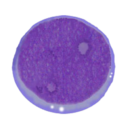The flow cytometric diagnosis of AML
From haematologyetc.co.uk
For most cases, the diagnosis of AML by flow cytometry is relatively straightforward. The problem lies in atypical cases and unusual diagnoses that may be missed.
1. The immunophenotype of AML blasts will (generally) reflect their primitive nature
 The typical "primitive" morphology of blast cells is generally accompanied by signs of primitive immunophenotype
The typical "primitive" morphology of blast cells is generally accompanied by signs of primitive immunophenotype
- Most often in AML typical features of immature cells will be found with: weak expression of CD45, together with expression of CD34 and/or CD117. Other markers may be useful in difficult cases (see Click for more detailed description)
- However in cases where blast cells show more differentiation their nature may be less clear. This is most frequently encountered in monocytic cases of AML or in APL (Click for a more detailed description)
2. The cases should express sufficient markers to allow myeloid lineage to be assigned
- Typical cases can generally be recognised by (see table for details)
- Atypical cases can still be identified based on a minimal feature set (see table for details)
- In unusual cases an extended marker panel may allow lineage assignment (see Table for details)
Are there atypical features?
- Expected abberency
- Feature that may give concern